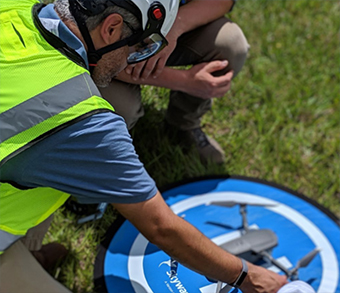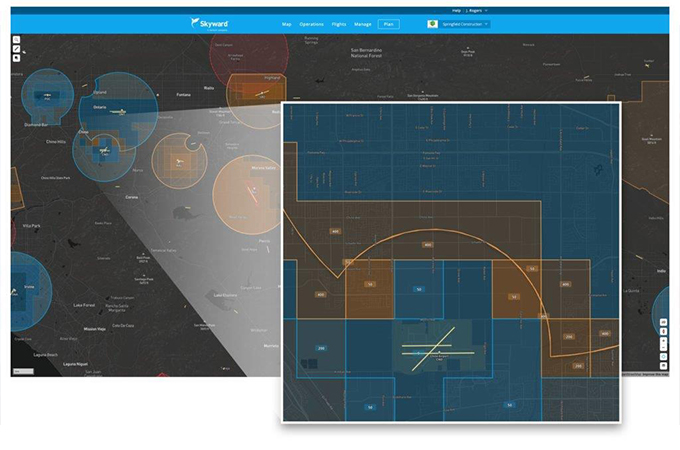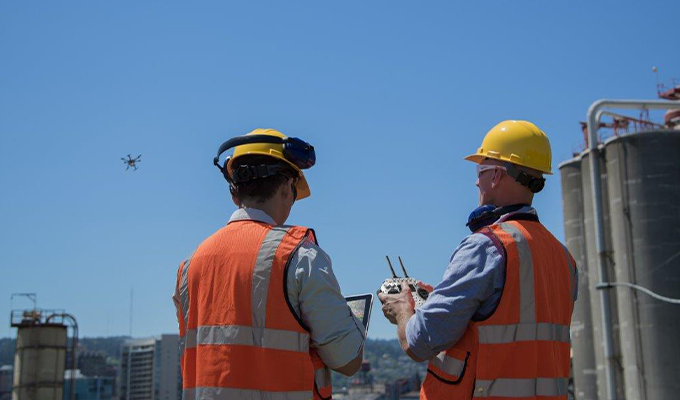By Teari Tennon
When a large company is looking into starting a drone program, objections may arise around risk. Safety personnel, lawyers, or executives may have questions like: How will you avoid airspace violations? What about data security? How will you maintain a fleet of drones?
These are important concerns that need to be addressed, but it’s also crucial to understand that drones can actually help reduce risks on the jobsite. For example, OSHA announced plans to use drones to collect evidence during inspections in certain workplace settings, including areas inaccessible or posing safety risks to inspection personnel. Fatalities resulting from falls continue to be a leading cause of death for today’s construction employees. In response, OSHA introduced the National Safety Stand-Down to raise fall hazard awareness across the country and help put an end to fall fatalities and injuries.
LOOKING TO DRONES AS A SAFETY ASSET
Today, more companies are realizing that, when all factors are considered, drones can help improve net risk exposure. The technology is increasingly recognized as a safety asset, not just a liability. For example, workers who previously climbed to heights can now perform their jobs from the ground, and some companies can even reduce their reliance on helicopters. In addition, drones typically allow for more frequent data collection on equipment and infrastructure compared to legacy methods. This means organizations are better able to head off problems before they happen.That’s not to say that drones don’t come with their own risks that need to be carefully managed. To help achieve net risk reduction, everyone involved needs to know how to operate drones while reducing risk as much as possible. This starts with standardizing everything across your organization’s drone program and the following steps will help steer your team in the right direction:

Set up standard operating procedures for drone safety
Oversight of a corporate drone program is a lot easier when all of your operations are standardized, digital, and reviewed regularly. When you have accessible records spanning all of your drone operations, it’s much easier to audit your operations and find potential weaknesses or liabilities. And when there’s a problem or an accident, you can quickly assess what may have gone wrong by looking at your records and processes.
First, you’ll want to set up policies and procedures so that every flight is consistently tracked, managed, and reported on. Some of the most important standards to document include:
- Qualification standards for all pilots
- Crew training
- Aircraft maintenance
- Quality control procedures for data collection
- Incident response protocols
- Procedures for special types of operations, such as flights at night
- Regulatory and internal compliance requirements
If you’re unsure about where to start, consulting with a drone management platform provider who also offers a standard operating procedures package is a simple and helpful way to map out your first steps. You’ll want to work with the organization’s professionals who can cover everything from equipment maintenance to pilot training and dealing with field mishaps, as well as help you create and implement a general operating manual that’s relevant to your company and puts safety and compliance at the heart of your drone program.
ENR Top 100 Contractor Moss & Associates, for example, knew they needed to set standards for safety and compliance before implementing drone technology. By turning to a start package designed to equip their team with the policies, equipment, software and training needed to launch a drone program, Moss was able to fast-track their drone program to success.
Choose a reliable drone airspace map
Accessing airspace safely requires a reliable drone airspace map. Not all maps are created equal. Be sure the map you choose includes controlled airspace, restricted areas, and temporary flight restrictions. You’ll also want to be able to use LAANC to access controlled airspace. Fortunately, today’s market offers drone airspace maps that are simple to understand, easy to us, and provide reliable information. Additionally, pilots are benefitting from drone management platforms that include ground intelligence such as buildings, walking paths, and power lines for enhanced flight situational awareness.
While you’re investigating airspace, be sure to also research local drone laws in your area. These rarely show up on airspace maps today, but they play an essential role in helping your team prove your compliance and avoid a run-in with the public or even law enforcement.

Consider aircraft and hardware concerns
A lot of factors go into choosing the right drone for your company. Drones differ in what jobs they’re best suited for, what payloads they can carry, and what technologies they have on board. You should address the following questions as you plan for drone safety on the jobsite:
- Will the drone meet Remote Identification requirements when they go into effect?
- Do you need a drone with obstacle avoidance?
- Will the signal range of the controller meet your job specs?
- Should country of origin affect your choice?
If you’re looking to build out your company’s drone fleet, keep in mind that many commonly-used enterprise drones can automatically sync flight logs to drone management platforms available today. Incorporating data into the business-essential software and project management tools your crew relies on every day not only strengthens, but also simplifies managing your company’s drone operations from the office to the field.
Make a plan for drone data security
Brasfield & Gorrie, one of the largest privately held construction firms in the United States, first began experimenting with a wide range of applications to see how drones could complement their operations. As the company’s operations grew, the team realized they needed a solution to manage their data and assets that was more navigable and functional than a shared spreadsheet. Turning to a drone operations management platform allowed Brasfield & Gorrie to maintain a single system of record for their entire drone program, while also mitigating risks with standardized workflows and ensuring that all operations complied with both FAA and internal regulations.
Often, companies need to fly drones on secure sites. Thus, the data they collect needs to be protected. It’s important to realize that there’s no single drone data security process or solution that will fit the needs of every company. Connect with you IT teams to discuss your approach for protecting sensitive data in each of the following phases:
- Collection: How will you store data in the field? Who will have access to memory cards or data storage devices?
- Transmission: Is transmitted data encrypted between the drone to your ground control system? If information is broadcast through the Internet, could it be intercepted?
- Upload: How will you move data from onboard memory storage to your business systems? Will you require a secure uplink, or that uploads only be performed in-office?
- Long-term storage: Where will drone data be securely stored? How long will you keep files before deleting them?
Prepare for drones connected over 4G LTE and 5G networks
We’re in an era of rapid technological change. As drone technology and regulations continue to progress, the future of drones will be enabled by connecting and controlling them over 4G LTE and 5G Ultra Wideband networks. This will contribute to the future of commercial drone operations, enabling things like:
- More secure and reliable connections to drones
- Rapid data processing over high bandwidth, low latency 5G connections
- Fully autonomous drone flights
- Universal Traffic Management (UTM)
- New and more powerful use cases
Traditional construction job site tasks such as performing structural inspections, collecting advanced measurements and exploring areas with hazardous materials and temperatures introduce safety risks for workers every day. Embracing drone technology as a safety asset can be a helpful approach to improve your team’s net risk exposure. It’s possible you’ll encounter skepticism as you build your drone program, but remember that carefully managing your operations and educating your entire team on safe and standard operating procedures can be a great first step towards achieving success. Of course, choosing the right drone airspace map, aircraft, hardware and drone data security plan, in addition to looking ahead to changes 4G LTE and 5G Ultra Wideband networks will bring, can help your team prevent additional risks as your operations continue to grow.
About the Author
Teari Tennon is originally from Pittsburgh, Pennsylvania, and now resides in Atlanta, Georgia. A graduate of the illustrious Morehouse College, Teari is a sales leader with a proven track record for building ongoing relationships and increasing organizations’ revenue. He is currently a demand generation specialist at Skyward, a Verizon company.


